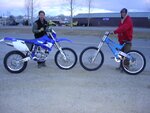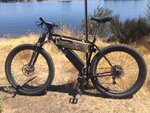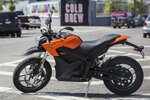Throughout mtb history there have been instances of using different diameter wheels on the front and the rear. 20/26, 24/26 were done in the 80's and early 90's. After 29" wheels debuted in '99 they were used in conjunction with 26" wheels also and in fact Trek even made a version. All these were set up with the larger diameter wheel in the front and the smaller in the rear. Also due to the fact that there wasn't a big variety of rim widths and tire widths there was a pretty good discrepancy in that the front was higher than the rear which had a negative effect on the geometry unless the bike was designed around the concept. Overall it didn't really catch the public interest.
As noted motorcycles, especially off road types, have used different wheel sizes for years. But primarily so that a fatter tire running on a wider rim of lesser diameter in the rear and a narrower tire on a narrower rim were the hot setup. Object being that the wider tire would aid in traction and the front was meant for precise steering control. Here is an effort I did back in 2000 that toyed with the concept.
View attachment 28800
But as you can see visually although the moto has different looking tire profiles they are very close to the same in overall diameter due to their tire aspect ratio's, whereas on the bicycle there is a more notable heighth differential. That bike was a pig to ride uphill in the days before bike parks and shuttling so it just ended up being a concept thing.
In the mid 2000's after 29" wheels were becoming more accepted and more rims and tires made available the 650b wheels started to show up making for the in between size and gained popularity pretty quickly, especially with the FS crowd and those that didn't like the idea of the 29" wheel. So more tires and rims were developed over the next 5 years for that market segment.
Along about this time ever widening tires leading up to Fat Bike 4" and beyond started showing up. Some even started using 4" tires in the front of their bikes with 29 or 27.5" wheels in the rear. The one thing that having that wide 4" tire brought out was that it needed a wide rim to accommodate it although up til then rim width's for 1.75-2.4 tires were all pretty much the same maxing out at inner width's of 25mm or so.
In 2011 Surly came out with their 3" Knard tire and they made a wide inner 40mm rim for it as seen here:
View attachment 28802
The end result of this was a whole new wheel diameter and the ability to run, especially in tubeless mode, lower in the teens psi than you could in a conventional high 20's with a 29" wheel and i25 rim. This enhanced traction and small bump compliance but also meant that you had to get a whole new bike because the diameter went up to around 30"es. It created the + movement that a few years later spawned the 27.5+ system that ended up becoming more popular as it was more within the realm of standard 29" geometry, and in fact came about due to that factor as it was meant for retrofitting wider tires on wider rims into existing 29"er frames.
My personal first grasp of the use of wider rims came about sort of by accident. I bought a CL single speed 29"er to send to my son down in the Bay Area that had a very nice wheelset made up of Phil Wood hubs and Kris Holm i35 rims. No way I was sending those down there to get stolen so I put another set I had on and sent the bike along. They came with some 2.2 tires on them and I put those on the wheels I sent and had the wheelset hanging around for a bit and one day I decided to put some tires on and install them on my Townie. I pumped them up to my usual 30psi and rode around and they felt pretty harsh so I started letting out bits of air. I did this a number of times until they started to squirm and when I checked the psi both front and rear were at around 10psi. I pumped them up to 15psi and that is where I ran them ever since. Great traction and small bump compliance were the most compelling features. But using only 2.3 tires which made me wonder if rim width didn't have as much to do with the ability to run low psi as tire width.
View attachment 28803
OK, to finally get to running different size wheels and sorry for the lead up but I feel it is important in how it has come about that for the last few years I have been using an i35 650b rim with a 2.8 tire on the rear of my mtb and an i35 700c rim with a 2.3 tire on the front. Like this:
View attachment 28804
Certainly the moto influence was a factor in my decision to go this route but also the fact that with the 2.3/2.8 tires, even on different rim sizes, are very close to the same diameter, enough so that they don't effect the geo of my bike so it handles as it always has even after adding the weight of the conversion. But the biggest factor is the ability to run 15psi in the front and rear. I found out that I don't like wide tires at low psi in the front, although it is very popular, because it made the steering seem grabby and imprecise. Mostly because I am so used to a narrower tire having used them for 30+ years I suppose but I do like the precision, small bump compliance and traction. The narrower tire on a wider rim squares off the tire profile also which seems to work just fine. But the wider rounder profile, as it is on the same rim width, rear tire is a traction monster and sucks up roots and rocks along the way such that I find no need for rear suspension. Tubeless is also a huge part of this equation also.
I find it funny in a way that it is becoming a "trend" but I do think it works, at least it does for my purposes.
As an aside on my Road eBike I tried the Road plus and I didn't really like it as I felt too much squirm due to the higher profile of the tire compared to my 40c 700c tires at the same psi, which I also tend to run lower than normal at 35psi so I went back to a 700c.
View attachment 28805






